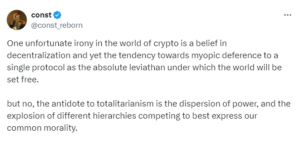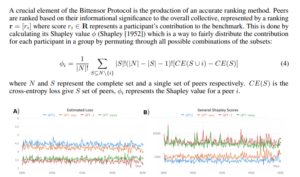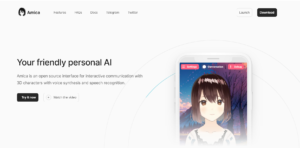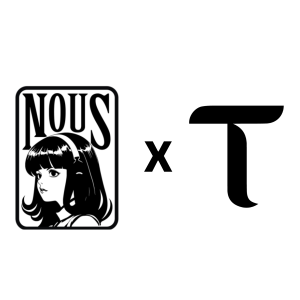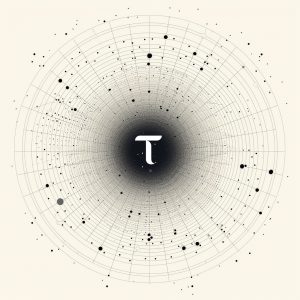Comment: Arbius is a standalone project and has nothing to do with Bittensor. This is a Guest Post, which compares Arbius with Bittensor.
Introduction
The true freedom from the clutches of totalitarianism does not lie in the hegemony of a single protocol. The path to a truly decentralized world is thus not through the elevation of a singular protocol to a pedestal but through nurturing an ecosystem where innovation, diversity, and competition are celebrated.
What is Arbius?
The Arbius project introduces a Proof-of-AI-Compute (PoAIC) algorithm to encourage reproducible computation, enabling anyone globally to access and offer AI models without a central authority. But how does it work? The algorithm functions by using the blockchain to validate and reward contributions to the network (similar like Bittensor Network Incentivize Mechanism), specifically focusing on the computational work associated with AI tasks
Here’s a breakdown of how PoAIC operates within the Arbius framework:
Submission of Tasks: Users initiate the process by submitting AI tasks to the network. These tasks include input data for AI models and an optional fee in AIUS tokens, the native cryptocurrency of Arbius. This submission is encapsulated in a blockchain transaction.
Computation Work: Solvers, who are network participants with computational resources (e.g., GPUs), pick up these tasks. They perform the necessary computations using the provided input data and the specific AI model referenced in the task.
Reproducible Computation: The PoAIC algorithm emphasizes reproducibility in computation. Solvers are required to generate outputs that are verifiable and reproducible by others, ensuring that the work can be independently validated. This aspect is critical for establishing trust and integrity within the network.
Verification of Work: Once a solver completes a task, they commit to the task (binding but hiding their actual solution), then reveal the proof of their work to the network. This proof includes unique cryptographic identifiers for the task. Other network participants can verify the correctness of the computation without needing to trust any central authority.
Reward Distribution: Solvers who successfully complete tasks and provide verifiable solutions are rewarded with AIUS tokens. The reward mechanism incentivizes computational contributions to the network, balancing the cost of computational resources with economic incentives. The amount of reward can be adjusted based on various factors, including the current and expected total supply of AIUS tokens, ensuring a sustainable ecosystem.
Arbius Vs. Bittensor: Comparison
This comparison seeks to illuminate similarities, distinctions, and individual value propositions of Bittensor & Arbius through a research and development (R&D) lens.
Project
Bittensor
Bittensor is introducing an infrastructure comprising the Route Network and Subnets, each playing an important role in distributing incentives and governing interactions within the network. Unlike traditional centralized systems, Bittensor’s architecture decentralizes control over incentive distribution, placing it in the hands of the community through a “network of networks” approach.
Subnets are the backbone of Bittensor, serving as self-contained ecosystems with specific incentive mechanisms that dictate the collaboration between miners and validators. This setup enables a variety of AI models, including advanced neural networks like GPT-3 and GPT-4, to operate on the platform
The Root Network further enhances governance, ensuring a fair & competitive environment for all network participants.
Arbius
In the Arbius ecosystem, tasks form the core interaction mechanism, functioning similarly to cryptocurrency transactions but with a unique twist: they’re tied to AI model computation and reward miners for their efforts. This system not only democratizes access to AI resources but also introduces a competitive yet collaborative environment where model creators can monetize their innovations in a decentralized manner. Through smart contracts, models can gather fees directly based on their usage, ensuring their ongoing availability and resistance to censorship.
Tokenomics and Incentive Structure
Bittensor
Bittensor rewards miners, subnet owners, and delegators, with an intricate reward distribution governed by the Yuma Consensus, emphasizing collective scoring and adaptive rewards based on performance.
To ensure equitable distribution of rewards, Bittensor employs Shapley values, a concept borrowed from cooperative game theory. Shapley values offer a fair and efficient way to allocate rewards among network peers based on their contributions
New TAO tokens are distributed among miners, subnet owners and delegators. It starts with a emission of 7200 TAO daily (0.034% of supply daily). Once half of the total supply has been issued, the rate of which new TAO are created will be reduced by 50%. Halvening the emissions every 4 years. The first halving predicted halvening will be October 2025. The token was fair launched with no pre-mine.
Arbius
Arbius takes a streamlined approach to its reward system, focusing on the direct contribution of computational resources towards AI tasks. By rewarding miners based on the speed and accuracy of task completion, Arbius incentivizes efficiency and high-quality output.
This mechanism is akin to a meritocratic system where the value provided to the network directly translates into economic rewards, embodying a clear and straightforward incentive model.
AIUS mirrors the scarcity and mining tokenomics of Bitcoin while adapting it to the context of AI computations. This ensures that as the total supply of AIUS tokens nears its cap, the rewards become more scarce and intensive to mine, driving competition and innovation among miners.
AIUS whilst also being launched with no pre-mine has a different model. 20% of the 1 million tokens are under a linear vesting scheme, streamed every second to pre-sale investors (2 years 10%), and team (4 years 10%). 20% is semi-locked on TGE and is put into a DAO (10%), LP Incentives (9%) and Initial Dex Supply (1%). The remaining 60% are allocated to miner rewards.
The majority of future emitted AIUS tokens are rewarded to miners who solve user tasks on AI models the fastest.
There is a target rate for mining emissions that exponentially declines over time (continuous halvening schedule). This decline in target rate over time is achieved by something akin to Bitcoin’s difficulty adjustment, but instead in Arbius the actual rate of reward per task is used as a difficulty adjustment instead. It goes up if there are less tasks mined, and goes down if there are more tasks mined. The actual rate should track the target rate by only a few percent.
The total emissions of AIUS daily is thus variable (especially when including vesting and DAO spending), but over time emissions fall drastically due to mining becoming more task intensive for less rewards.
As an example on target rates, 1138 AIUS is the target rate for the first day (0.113% of Total Max Supply Daily). After 365 days (1 year), the mining rewards target rate will be drop down to 570 AIUS per day (0.057% of Total Max Supply Daily), and the actual rate of mining emissions will vary slightly due to the difficult adjustment mechanism.
| AIUS | TAO | |
| Maximum Supply | 1.000.000 | 21.000.000 |
| Pre-Sale | yes | no |
| Halving | continuous halvening schedule | every 4 years |
| Token Burning/ Recycle | no | yes |
Infrastructure
Bittensor
Bittensor uses its own blockchain and is a Layer 1 developed with the Polkadot SDK. This allows for a tailor-made infrastructure, offering benefits such as customizability.
Arbius
Arbius, on the other hand, positions itself within the Ethereum ecosystem, specifically on Arbitrum Nova, an Ethereum Layer 2 solution. This strategic decision grants Arbius immediate access to Ethereum’s vast DeFi liquidity and established user base. Moreover, being on a Layer 2 solution, Arbius benefits from reduced transaction fees and enhanced scalability, crucial for AI computations and transactions.
| AIUS | TAO | |
| Blockchain Type | Layer 2 | Layer 1 |
| Programming Language | Typescript & Solidity | Rust & Python |
Governance
Bittensor
Bittensor’s governance structure initially revolves around a centralized foundation complemented by a bicameral legislative system. This structure is characterized by a leading Triumvirate responsible for proposal creation, primarily consisting of Opentensor Foundation employees, and a Senate formed from the top delegate key holders. This design reflects a traditional approach to governance in the early stages of the network, aiming to provide a stable and guided development path. However, Bittensor expresses intentions to transition towards community ownership and a more decentralized governance model over time, although specific future plans and mechanisms for this transition remain unspecified.
Arbius
Arbius adopts a markedly simpler and more direct approach to governance. From the outset, Arbius is designed to be governed by a DAO (Decentralized Autonomous Organization), which also serves as a public treasury to fund the ongoing development and expansion of the Arbius ecosystem. This governance model is intended to ensure that Arbius remains adaptable and responsive to future demands and technological advancements.
The registration of AI models, distribution of mining rewards, and other key operational aspects are subject to DAO oversight, allowing for a governance framework that evolves through community voting and participation. This design aims for simplicity and flexibility, facilitating a gradual shift towards fuller community control and ownership.
| Bittensor | Arbius | |
| Governance Structure | Foundation with a bicameral legislature, including a Triumvirate and Senate | Designed to be completely governed by the community through the DAO in the long term. |
| Decision Making | Triumvirate responsible for proposal creation. | Community voting on key decisions including AI model registration and mining reward distribution. |
| Flexibility | Initial centralized control with a future aim towards decentralization | Will deploy DAO after initial bootstrapping. Proposals can be voted to pass through for protocol upgrades or DAO spending, for future-proofing development. |
Vision
Bittensor
Bittensor’s vision aims to establishing a decentralized network that mimics the human brain’s neural network. At its core, Bittensor facilitates a collaborative ecosystem where each ‘neuron’—represented by independently owned and operated machine learning models.
Arbius
Arbius envisions a future where artificial intelligence transcends current limitations by embracing decentralization, economic innovation, and a focus on accessibility. The network aims to break down barriers to AI development and deployment, creating an open, censorship-resistant ecosystem that encourages innovation and competition.
By leveraging GPU miners and a tokenized reward system, Arbius enables anyone to participate in the AI economy, whether as a model creator, a miner, or a user. The project is designed to simplify the integration of decentralized AI capabilities into applications, making AI more accessible to developers, researchers, and users alike. Arbius’s vision is to democratize AI, ensuring that the power of artificial intelligence is in the hands of the many rather than a few centralized entities.
Ecosystem Apps
Bittensor
Noteworthy applications on Bittensor include: Chat with Hal, a personal AI assistant, Reply Tensor, which focuses on AI-generated content for social media and Corcel a Chatbot
Arbius
Arbius simplifies the integration of AI into applications by allowing developers direct access to AI models through smart contracts.
Arbius is expanding its ecosystem with the development of a decentralized autonomous agent marketplace and the integration of Amica, an open-source 3D personal AI.


